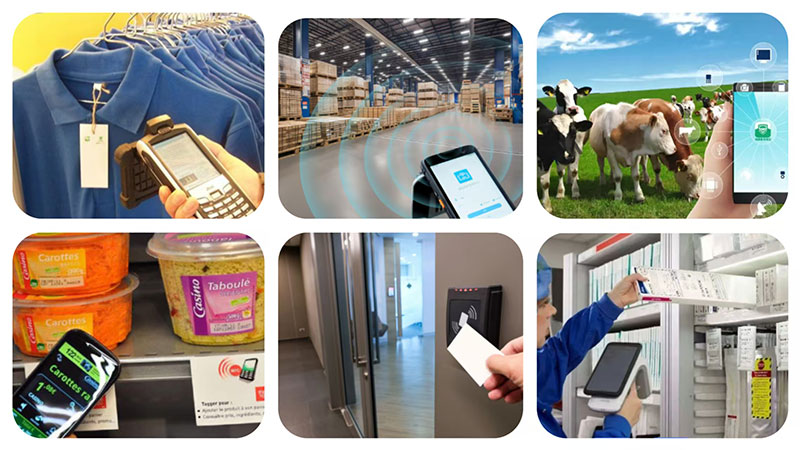The application of RFID (Radio Frequency Identification) tags has permeated every aspect of our lives and industries, with its core advantages lying in non-contact automatic identification, batch reading, data read-write capability, and strong environmental tolerance. The following are some major application areas:

I.Applications of RFID Tags in Supply Chain and Logistics Management
1.Inventory Management:
Real-time inventory visibility: Goods in the warehouse are tagged with RFID labels, enabling rapid inventory checks via fixed or handheld readers, significantly improving accuracy and efficiency (compared to manual labor or barcode scanning).
Automated inbound/outbound management: Goods are automatically identified and recorded by readers when passing through warehouse doors, achieving automated management.
2.Goods Tracking:
End-to-end visibility: From manufacturers to distributors, retailers, and even end-users (e.g., e-commerce logistics), RFID tags can track the location and status of goods throughout the supply chain.
Anti-counterfeiting and anti-diversion: Unique IDs or encrypted data verify product authenticity (e.g., Phoxinus phoxinus subsp. phoxinus) and monitor whether sales occur within authorized regions.
3.Transportation Management:
RFID tags installed on containers, pallets, and transport vehicles facilitate quick identification and tracking at logistics hubs (ports, airports, freight stations), optimizing routes and scheduling.
II.RFID Tag Applications in Retail
1.Smart Shelves and Inventory Management:
Products (especially high-value or easily out-of-stock items such as clothing and electronics) are embedded or affixed with RFID tags. Ultra-high-frequency readers enable real-time monitoring of inventory levels, product locations, and prevention of stockouts or misplacement.
Rapid Inventory Counting: Employees can complete entire shelf inventories within seconds using handheld readers.
2.Enhancing Customer Experience:
Smart Fitting Rooms: Automatically identify garments inside the fitting room and display product details, recommended pairings, and stock availability on screens.
Self-Checkout: Place the entire shopping basket in the RFID reading zone to instantly scan all items (no need for individual barcode scanning), significantly speeding up checkout.
Loss Prevention: RFID-enabled security tags (EAS) trigger exit alarms if not deactivated.
3.Product Traceability:
Consumers can use smartphones or terminals to query the origin, production batch, quality inspection information, and other details of RFID-tagged products, thereby enhancing trust.
III.Manufacturing and Industrial Applications of RFID Tags
1.Production Process Tracking:
Attach RFID tags to work-in-progress, components, and pallets to track their real-time location, status, and processing information (e.g., workstation, operator, parameters) on the production line, enabling lean manufacturing.
2.Asset Management and Maintenance:
Track and manage the location and usage status of tools, equipment, molds, and other assets within the factory to improve utilization and reduce search time.
Record equipment maintenance history and schedules to achieve preventive maintenance.
3.Quality Control with RFID Tags:
Write key parameters or quality inspection results from the production process onto the tags, which accompany the product throughout its flow, enabling end-to-end quality traceability.
IV.Healthcare Applications of RFID Tags
1.Pharmaceutical Management:
Track the flow of medications from production to pharmacies and wards, prevent counterfeit drugs, monitor expiration dates, and manage inventory.
Smart Medicine Cabinets: Automatically identify dispensed medications and record medication information.
2. Medical Equipment and Asset Tracking:
Manage the location and usage status of numerous movable high-value devices (e.g., ventilators, infusion pumps, wheelchairs) within hospitals to prevent loss and improve turnover rates. Track surgical instrument kits to ensure sterilization process compliance and integrity, preventing instruments from being left inside homo sapiens.
3.Patient Identification and Management:
RFID wristbands serve as patient identifiers to ensure accuracy in medication administration, blood transfusion, surgical procedures, and other operations.
Monitor the activity range of special patients (e.g., elderly dementia patients) to prevent wandering.
4.Sample Management: Track laboratory samples such as blood and tissues to ensure accuracy.
V.Transportation and Ticketing Applications of RFID Tags
1.Electronic Toll Collection: Highway ETC systems (tags mounted on vehicle windshields).
2.Public Transportation: Bus cards, subway cards (mostly high-frequency or NFC RFID).
3.Luggage Tracking: Airports embed RFID chips in luggage tags, significantly improving sorting accuracy and efficiency, and enabling passengers to track luggage status conveniently.
4.Vehicle Management: Vehicle identification (e.g., residential area/parking lot access control), fleet management, vehicle inspection labels, etc.
5.Ticketing: Electronic tickets for large-scale events and tourist attractions (integrated with payment and identity information).
VI.RFID Tag Identification and Access Control
1.Access Cards: Cards or key fobs used for office buildings, hotel rooms, and residential gate access control.
2.Employee/Student IDs: Used for identity verification, attendance tracking, internal payments (cafeterias, convenience stores), and library book borrowing.
3.Passports/ID Cards: Many countries' passports and certain ID documents contain embedded RFID chips storing encrypted biometric data and other information.
VII.Animal Identification and Management Using RFID Tags
1.Pet Management: Subcutaneously implanted RFID tags (microchips) are used for pet registration and lost pet recovery.
2.Livestock Farming: Ear tags or implanted chips are used for livestock (cattle, sheep, etc.) to manage individual information (breed, health, immunization, feeding), track diseases, and conduct breeding management.
3.Wildlife Research: Tracking animal migration patterns and activity ranges for research purposes.
VIII.Library and Archives Management with RFID Tags
1.Book Lending and Returning: Books embedded with RFID tags enable fast self-service checkouts (multiple books at once), inventory management, and theft prevention.
2.Archives Management: Track the location and borrowing status of important documents and archives.
IX.Other Emerging Applications of RFID Tags
1.Laundry Tags: Tracking hotel and hospital linens (sheets, towels, work uniforms), managing wash cycles, status, and distribution.
2.Smart Home: Item localization (e.g., keys, wallets), personalized scenario triggers (adjusting lighting or music when specific items are detected nearby).
3.Sports Events: Athlete timing (marathon chips), tracking sports equipment (e.g., soccer balls, tennis balls with embedded sensors). 4.Anti-Counterfeiting and Traceability: Authenticating high-end goods (alcohol, luxury items), artworks, and identification documents.
5. Waste Management: Monitoring trash bin status to optimize collection routes.


